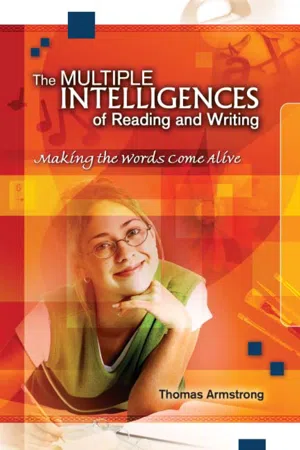
The Multiple Intelligences of Reading and Writing: Making the Words Come Alive
- 153 pages
- English
- PDF
- Available on iOS & Android
The Multiple Intelligences of Reading and Writing: Making the Words Come Alive
About This Book
We normally think of reading and writing as skills that are a part of linguistic intelligence. In The Multiple Intelligences of Reading and Writing: Making the Words Come Alive, Thomas Armstrong shows how involving the other seven intelligences--logical-mathematical, spatial, bodily-kinesthetic, musical, interpersonal, intrapersonal, and naturalistic--will help students acquire reading and writing skills, especially those students who are not particularly strong in linguistic intelligence.
The Multiple Intelligences of Reading and Writing appeals to all educators who work with reading and writing skills, from the preschool teacher leading the class in phonemic awareness activities to the post-graduate professor helping students examine kinesthetic imagery in Shakespeare's plays. The book combines Howard Gardner's MI theory and recent brain research on reading and writing with historical, anthropological, biographical, and psychological perspectives on literacy. Armstrong pulls the research together to show you how to engage students by infusing the study of words with imagery, logic, oral language, physical activity, emotion, music, social involvement, and nature experiences.
Armstrong provides hundreds of ideas, strategies, tips, and resources for teaching everything from grammar and spelling to word decoding and reading comprehension. His strategic approach synthesizes the best reading and writing methods for application in preK-12 classrooms, literacy programs, speech and language pathology groups, one-to-one tutoring sessions, and all other settings where words are the focus of learning. Armstrong shows you how to empower your students with literacy skills for life.
Note: This product listing is for the Adobe Acrobat (PDF) version of the book.
Frequently asked questions
Information
Table of contents
- Cover
- Title Page
- Copyright
- Dedication
- Table of Contents
- Introduction
- Chapter 1: Literacy, Multiple Intelligences, and the Brain
- Chapter 2: Coming to Grips with the Musculature of Words
- Chapter 3: Seeing the Visual Basis of Literacy
- Chapter 4: Grooving with the Rhythms of Language
- Chapter 5: Calculating the Logic of Words
- Chapter 6: Feeling the Emotional Power of Text
- Chapter 7: Relating to the Social Context of Literacy
- Chapter 8: Speaking Out About the Oral Basis of Reading and Writing
- Chapter 9: Opening the Book of Nature
- Conclusion
- References
- Index
- About the Author
- Related ASCD Resources
- Search this Book